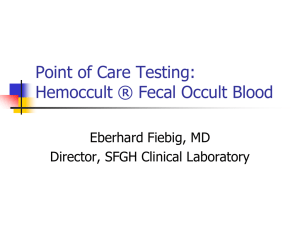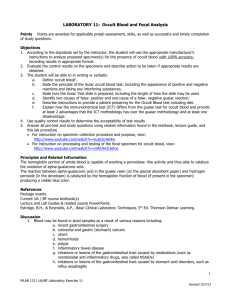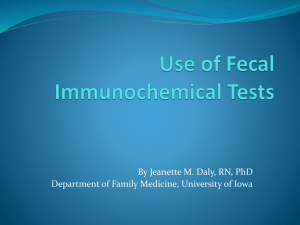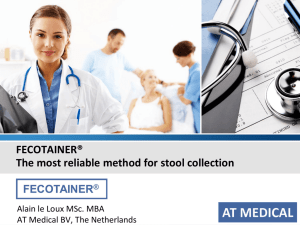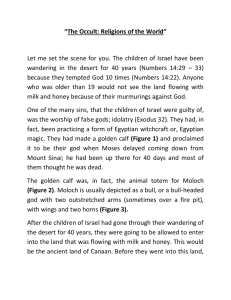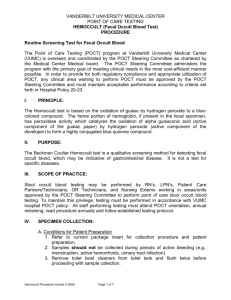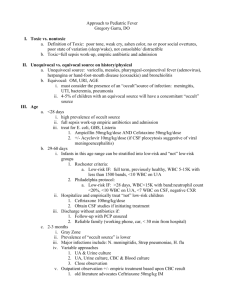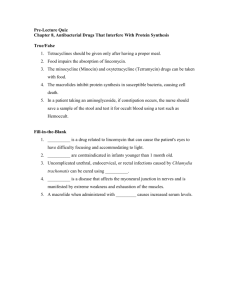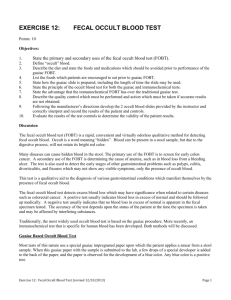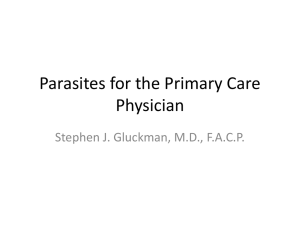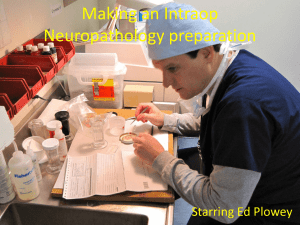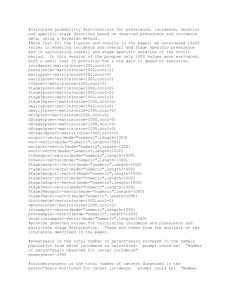Procedure: Guaiac Testing – Screening For Fecal Occult Blood
advertisement
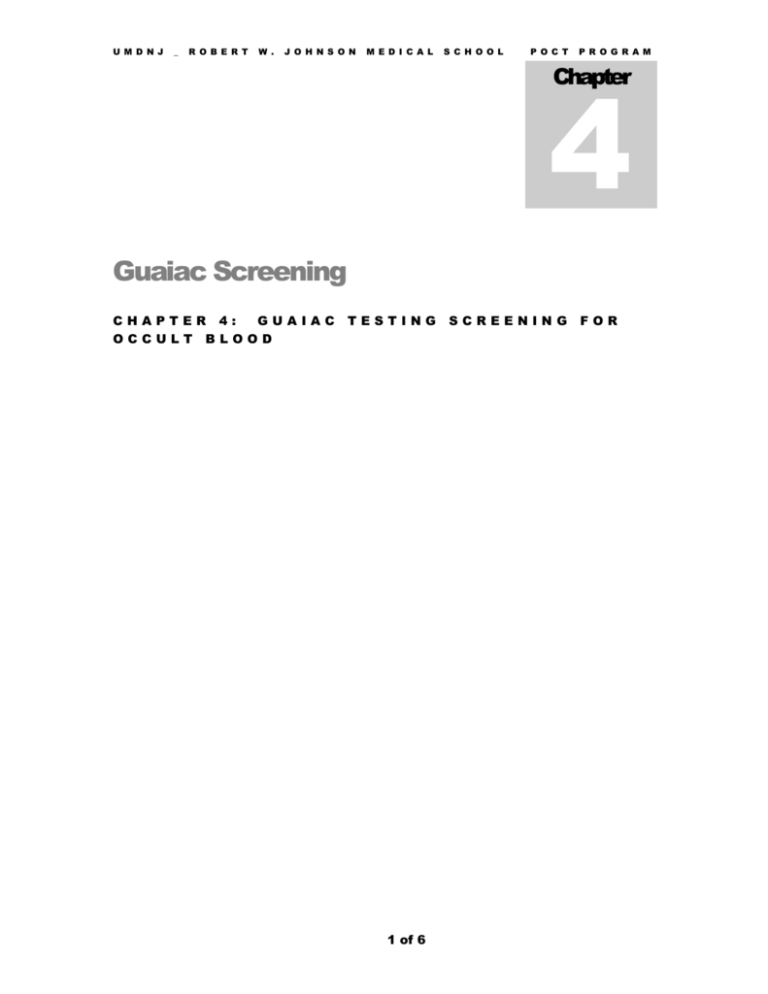
U M D N J _ R O B E R T W . J O H N S O N M E D I C A L S C H O O L P O C T P R O G R A M 4 Chapter Guaiac Screening CHAPTER 4: GUAIAC OCCULT BLOOD TESTING 1 of 6 SCREENING FOR U M D N J _ R O B E R T Procedure: Guaiac W . J O H N S O N M E D I C A L S C H O O L P O C T P R O G R A M Testing – Screening for Fecal Occult Blood POLICY: The stool occult blood slide specimen test is collected by the patient after he or she has been instructed by an RN, LPN, or medical assistant in proper diet preparation and proper test application procedure. A physician may collect a specimen at his/her diagnostic discretion upon exam. Stool occult blood slide tests may be developed and interpreted by an RN, LPN, or medical assistant/medical technician certified in testing procedure. PURPOSE: To detect the presence of fecal occult blood. REAGENTS AND MATERIALS SUPPLIED: Three stool occult blood slides, HEMOCULT Three wooden applicators Stool Occult Blood Diet Preparation Information Sheet (sample sheet follows this procedure) with envelopes addressed to provider. PRINCIPLE: The presence of blood in the stool is determined qualitatively in the hemocult test. The heme portion of hemoglobin reacts with a special quaiac impregnated paper oxidizing the guaiac when hydrogen peroxide (the active ingredient in the developer) is added which then produces a blue color. CLINICAL REASONS FOR TEST: The test is recommended for use as a diagnostic aid during routine examinations to detect fecal occult blood. The test is also useful in monitoring bleeding in patients with iron deficiency anemia or recuperating from surgery, peptic ulcer, ulcerative colitis and screening programs for colorectal cancer when a special diagnostic diet is used. A positive test is not specific for any disease. SAMPLE COLLECTION AND STORAGE: Patient Preparation: Whenever possible, the patient should be on the ‘Special Diagnostic Diet’ starting at least 48 hours prior and continuing through the collection period. Give the patient stool occult blood diet preparation educational materials as supplied by manufacturer. Review sheet with patient and reinforce the importance of adhering to the diet to ensure proper test result. Specimen: Preferred – Stool specimen should be collected from the patient who has been 2 of 6 U M D N J _ R O B E R T W . J O H N S O N M E D I C A L S C H O O L P O C T P R O G R A M on a Special Diagnostic Diet 48 hours prior to collection. Three consecutive bowel specimens should be collected on Hemoccult Slides. Acceptable Specimens: Three consecutive bowel movements collected in separate containers One random collection without Special Diet restrictions. Acceptable collection containers are plastic containers of approximately 100cc (urine type) or collection by the patient on Hemoccult slides. Dried slides containing specimen are stable up to 14 days stored at 15-30 C. Unacceptable Specimens: Specimens should not be collected if hematuria or obvious rectal bleeding is present, such as might occur with hemorrhoids. Pre-menopausal women must be instructed to avoid collecting feces during or in the first three days after a menstrual cycle. Assay specimen – a thin smear of stool is applied to either a Hemoccult Slide or a Hemoccult tape for analysis. KIT STORAGE AND STABILITY Hemoccult slides or tape should be stored at 15-30 °C (59–86°F). in the original packaging. Do not refrigerate or freeze. Protect from heat and light. Do not store near volatile chemicals (iodine, bromine, chloride or ammonia). Hemocult Developer should be stored at 15-30 °C (59–86°F). Protect from heat. Keep bottle tightly capped when not in use. The Hemocult kit should be stored at room temperature, 15-30 °C (59–86°F), out of direct sunlight. Kit contents are stable until the expiration date printed on the outer box. Do not freeze. QUALITY CONTROL: Control Materials: 1. When testing using Hemoccult Tape, a positive control is prepared monthly using 50ul whole blood in 250ml if DI H20. It is prepared and stored in a glass stopped bottle and kept under the hood in hematology. The bottle should be dated one month from preparation time and discarded when expired. 2. Deionized water can be used as a negative control. The bottle should be dated one month from preparation time and discarded when expired. 3. When using the Hemoccult slides, there is a performance monitor feature at the bottom of the slide for quality control purposes. This is an internal calibrator which must perform acceptably or the patient test results must be rejected. Frequency Performed Run a positive and negative control with each batch of patient specimens being tested. Develop the test in the same manner as all patient specimens. Tolerance Limits & Corrective Action The positive control must show a blue color when tested along with patients and negative control must be colorless. Record Quality Control results along with patient results in the Log Book. 3 of 6 U M D N J _ R O B E R T W . J O H N S O N M E D I C A L S C H O O L P O C T P R O G R A M Procedure: Test Procedure 1. Give patient stool occult blood diet preparation educational sheet as supplied by the manufacturer. Review sheet with patient and reinforce importance of adhering to diet to ensure proper test results. 2. Explain stool occult blood procedure as follows: a. Fill in the information on the front of the card. b. Collect a small stool sample on one end of the applicator. c. Apply a thin smear inside box A. d. Reuse applicator to obtain second sample from different part of stool, apply thin smear inside box B. Close cover. e. Repeat procedure once each day for three days. 3. Caution patient not to collect specimen during menses or while suffering from hemorrhoids. 4. Inform patient to protect slides from heat, sunlight, and fluorescent light. 5. Instruct patient to return slides immediately in preaddressed envelope. Development Procedure: HEMOCCULT TAPE This product is mainly used for hospital in-patient populations on stool specimens submitted to the laboratory. 1. With a wooden applicator stick collect a small specimen. Spread a very thin smear of stool using a piece of tape about 1 inch long. Let dry 3-5 minutes. At the same time, apply a drop of positive control and drop of DI H20 as negative control on another piece of tape. Let dry. 2. Apply one or two drops of Hemoccult Developer to the reverse side of the tape, directly over the smear. INTERPRETATION OF RESULTS: Read results on the reverse side within 60 seconds. Any trace of blue color on or at the edge of the smear is positive for occult blood. HEMOCCULT SLIDE Slides are submitted to the POCT location from a patient who has been instructed by their physicians or other trained medical personnel on the proper collection of specimens. 1. Open flap in back of the slide. 2. Apply 2 drops of Hemoccult developer to each smear. 3. Read results visually within 60 seconds. Any trace of blue color on or at the edge of stool smear is considered positive for occult blood. Lack of blue color development indicates the absence of blood. 4. After patient results are noted, apply one drop of developer between the positive and negative monitor areas. 5. Read Internal QC results within 10 seconds. If the slide and developer are functional, a blue color will appear in the positive monitor area, while no blue color will appear in the negative area. 4 of 6 U M D N J _ R O B E R T W . J O H N S O N M E D I C A L S C H O O L P O C T P R O G R A M INTERPRETATION OF RESULTS: Positive Result: Any trace of blue color developed on or at the edge of a smear in which external quality control is valid, is considered positive for the presence of occult blood. The lack of a blood color on a reagent strip in which external quality control is valid, is considered negative for the presence of occult blood. Follow-up Procedure: Inform patient that follow-up care will be dependent upon test results. He or she will be notified by the provider, if further tests are indicated. DOCUMENTATION OF RESULTS Patient results are reported as either negative or positive and are recorded on the appropriate patient record form labeled with the patient’s name. Document that the patient has received instructions regarding follow up care. LIMITATIONS AND INTERFERING SUBSTANCES: Red meat may cause false positive results and should be eliminated from the diet 48 hours prior to and during the sampling phase. Fruits and vegetables high in peroxidase such as turnips, broccoli, horseradish, parsnip, cauliflower, and cantaloupe may cause false positive results. High doses of ascorbic acid (Vitamin C, 250 mg/day or more) may cause false negative results. Oral medications such as aspirin or other non-steroid anti-inflammatory drugs should be avoided for 7 days prior to and during the test period. Heavy alcohol consumption may cause irritation or bleeding of the GI tract and should be eliminated from the diet 48 hours prior to and during the sampling procedure. Contamination with menstrual blood or active bleeding due to hemorrhoids or polyps will give a false positive test. Many toilet sanitizers generate chlorine and are reported to cause false positive reactions if the test areas are contaminated on the Hemoccult Slide. NOTES: Testing for occult blood is useful as a screening mechanism for lesions of the lower GI tract. Malignant tissues such as adenocarcinomas, as well as other malignant lesions of the bowel are more fragile than healthy tissues; their presence results in abnormal loss of blood into the lumen of the gut. Frequently, the detection of blood in feces is the first indication of an abnormal gastrointestinal tract pathology. In addition to malignancy, ulcers polyps, ulcerative colitis, regional enteritis, and diverticulitis may result in blood loss into the gut and yield positive results when testing for occult blood. If sent through the mail, collected specimen slides must be placed in special mailing pouches. WARNINGS AND PRECAUTIONS: Do not use the kit contents beyond the expiration date printed on the outside of the box. 5 of 6 U M D N J _ R O B E R T W . J O H N S O N M E D I C A L S C H O O L P O C T P R O G R A M Use appropriate precautions in the collection, handling, storage and disposal of patient samples and used kit contents.2 Discard used material in a proper biohazard containers. ASSISTANCE: If you require assistance, please contact your POCT site supervisor, the POCT clinical coordinator, or theDepartment of Pathology - UDL central administrative office. If necessary, they will contact the manufacturer’s technical support hotline. REFERENCES: 6 of 6
